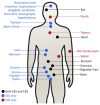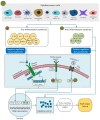Antimicrobial and Antiviral (SARS-CoV-2) Potential of Cannabinoids and Cannabis sativa: A Comprehensive Review
- PMID: 34885798
- PMCID: PMC8658882
- DOI: 10.3390/molecules26237216
Antimicrobial and Antiviral (SARS-CoV-2) Potential of Cannabinoids and Cannabis sativa: A Comprehensive Review
Abstract
Antimicrobial resistance has emerged as a global health crisis and, therefore, new drug discovery is a paramount need. Cannabis sativa contains hundreds of chemical constituents produced by secondary metabolism, exerting outstanding antimicrobial, antiviral, and therapeutic properties. This paper comprehensively reviews the antimicrobial and antiviral (particularly against SARS-CoV-2) properties of C. sativa with the potential for new antibiotic drug and/or natural antimicrobial agents for industrial or agricultural use, and their therapeutic potential against the newly emerged coronavirus disease (COVID-19). Cannabis compounds have good potential as drug candidates for new antibiotics, even for some of the WHO's current priority list of resistant pathogens. Recent studies revealed that cannabinoids seem to have stable conformations with the binding pocket of the Mpro enzyme of SARS-CoV-2, which has a pivotal role in viral replication and transcription. They are found to be suppressive of viral entry and viral activation by downregulating the ACE2 receptor and TMPRSS2 enzymes in the host cellular system. The therapeutic potential of cannabinoids as anti-inflammatory compounds is hypothesized for the treatment of COVID-19. However, more systemic investigations are warranted to establish the best efficacy and their toxic effects, followed by preclinical trials on a large number of participants.
Keywords: COVID-19; antibiotic resistance; antimicrobial; cannabinoid; cannabis; food-borne; plant pathogen.
Conflict of interest statement
The authors declare no conflict of interest.
Figures




Similar articles
-
The Role of Cannabis sativa L. as a Source of Cannabinoids against Coronavirus 2 (SARS-CoV-2): An In Silico Study to Evaluate Their Activities and ADMET Properties.Molecules. 2022 Apr 27;27(9):2797. doi: 10.3390/molecules27092797. Molecules. 2022. PMID: 35566148 Free PMC article.
-
Current and Potential Use of Biologically Active Compounds Derived from Cannabis sativa L. in the Treatment of Selected Diseases.Int J Mol Sci. 2024 Nov 27;25(23):12738. doi: 10.3390/ijms252312738. Int J Mol Sci. 2024. PMID: 39684447 Free PMC article. Review.
-
In search of preventive strategies: novel high-CBD Cannabis sativa extracts modulate ACE2 expression in COVID-19 gateway tissues.Aging (Albany NY). 2020 Nov 22;12(22):22425-22444. doi: 10.18632/aging.202225. Epub 2020 Nov 22. Aging (Albany NY). 2020. PMID: 33221759 Free PMC article.
-
Cannabis as antivirals.J Appl Microbiol. 2023 Jan 23;134(1):lxac036. doi: 10.1093/jambio/lxac036. J Appl Microbiol. 2023. PMID: 36626776 Review.
-
Anti-Inflammatory and Antiviral Effects of Cannabinoids in Inhibiting and Preventing SARS-CoV-2 Infection.Int J Mol Sci. 2022 Apr 10;23(8):4170. doi: 10.3390/ijms23084170. Int J Mol Sci. 2022. PMID: 35456990 Free PMC article. Review.
Cited by
-
Cannabinoids in Integumentary Wound Care: A Systematic Review of Emerging Preclinical and Clinical Evidence.Pharmaceutics. 2024 Aug 17;16(8):1081. doi: 10.3390/pharmaceutics16081081. Pharmaceutics. 2024. PMID: 39204426 Free PMC article. Review.
-
Substances of abuse and their effect on SAR-CoV-2 pathogenesis.NeuroImmune Pharm Ther. 2023 Jul 31;2(3):301-316. doi: 10.1515/nipt-2023-0004. eCollection 2023 Sep. NeuroImmune Pharm Ther. 2023. PMID: 38013836 Free PMC article. Review.
-
Anti-Microbial Activity of Phytocannabinoids and Endocannabinoids in the Light of Their Physiological and Pathophysiological Roles.Biomedicines. 2022 Mar 9;10(3):631. doi: 10.3390/biomedicines10030631. Biomedicines. 2022. PMID: 35327432 Free PMC article. Review.
-
Cannabinoid-Inspired Inhibitors of the SARS-CoV-2 Coronavirus 2'-O-Methyltransferase (2'-O-MTase) Non-Structural Protein (Nsp10-16).Molecules. 2024 Oct 28;29(21):5081. doi: 10.3390/molecules29215081. Molecules. 2024. PMID: 39519722 Free PMC article.
-
Aqueous Extracts from Hemp Seeds as a New Weapon against Staphylococcus epidermidis Biofilms.Int J Mol Sci. 2023 Nov 7;24(22):16026. doi: 10.3390/ijms242216026. Int J Mol Sci. 2023. PMID: 38003214 Free PMC article.
References
-
- Burnett-Boothroyd S., McCarthy B. Textiles for Hygiene and Infection Control. Elsevier; Amsterdam, The Netherlands: 2011. Antimicrobial treatments of textiles for hygiene and infection control applications: An industrial perspective; pp. 196–209.
-
- Shahid M., Sobia F., Sahai A., Tripathi T., Singh A., Shahzad A., Khan H.M. Umesh Plant Natural Products as a Potential Source for Antibacterial Agents: Recent Trends. Anti-Infect. Agents Med. Chem. 2009;8:211–225. doi: 10.2174/187152109788680199. - DOI
Publication types
MeSH terms
Substances
LinkOut - more resources
Full Text Sources
Molecular Biology Databases
Miscellaneous

